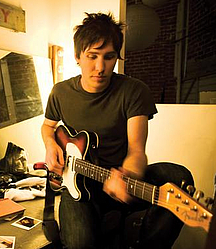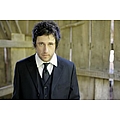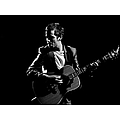Paul Freeman Biography
"I liked the idea of calling the album That's How It Is," says the newly emerging singer-songwriter-frontman Paul Freeman, "because it's direct and it's real. It's one of the songs of mine that people really seem to like." Freeman, who often closes his shows with the song, combines his love and devotion to word-craft with an equally passionate and adroit command of vintage rock-pop on his much-awaited full-length debut album. Paul's music bursts at the seams with intelligence, complexity melodic exhilaration and life-affirming exuberance. Freeman's a "poetry fan" filled with "the utmost respect" for "anybody that's a good writer… whether it be a songwriter or a poet or a screenwriter. It's an underestimated art." In fact Paul was born in South Wales, a town not more than 20 minutes away from the birthplace of his favorite poet Dylan Thomas. Although Paul didn't realize that Thomas had been a neighbor, his album's title song -- "That's How It Is" -- was "somewhat influenced by Thomas's 'Death Has No Dominion'." But what cannot be underestimated is Paul's fervent love and dedication to the art of rock and pop music. It all began when Paul was very young and began delving into the myriad sounds of his father's extensive record collection. Although he couldn't play a note, Paul's dad, a railway worker, was a "huge music buff" who'd hang stereo speakers out the window so he could groove to rocking modern sounds while cutting the grass with a manual rotary mower. "The house was never quiet," says Paul, who gleefully absorbed the music that poured into his life. "I got into Wings," he'll admit today, "before I got into the Beatles." One pre-teen afternoon, riding his bike around the neighborhood, Paul Freeman found his first guitar, a battered and beaten acoustic, its warped neck sticking out of the top of a dumpster. Although the guitar had but four strings--"The A and the high E were missing"--Freeman fell in love. So much so that by the next Christmas, his parents and grandparents joined forces to buy 12-year-old Paul a proper tune-able six-string and a book of chords to go with it. "I sat and listened to records and played along with them," he remembers. "The first song I learned was 'Get It On' (aka 'Bang A Gong' in the US) by T. Rex. And then I started learning the Beatles. The first Beatles song I learned was 'Hey Jude,' which was actually my mother's record. She wasn't into music but she had that, the Commodores and Simply Red. Some of those soul records were really good." At age 14, Paul wrote his first original song, an ode to yearning called "Some Day." During high school, Freeman went to work at the Linford Manor, a legendary recording studio north of Oxford. Working at the Manor with a variety of musicians--including Paul Weller, Julian Cope, Skunk Anansie and others--during the twilight of Britpop, Paul had his "first eye-opening experience to how the music industry really worked…as opposed to just being a music fan listening to Oasis. There were all these wonderful instruments lying around. I would never go to bed, I would just stay up and play them. What really got me into playing the piano was having access to the grand piano at the studio. I never had a lesson in anything. It's all self-taught and self-researched." Realizing that Freeman owed it to himself to at least take a shot at freeing the music that burned inside him, Paul moved to London. "At this point, I was finding my stride as a songwriter." While London proved a fertile ground for real life experience and aesthetic inspiration, the town's music scene in those first years revolved around the pulsing strobing techno of clubland. "I always felt kind of out of place," Paul confesses, "because I wanted to write classic, dare I say it, pop music. I was also so drawn to Oasis because they came out and they were unashamedly writing pop songs, music written by blokes for blokes, great songs with loud guitars." Believing that "a change is as good as a rest," Paul decided to move once again, this time to the states. "I'd written eight songs for somebody else's records and came to Los Angeles to record them," he offers. "I got a flat in Santa Monica and I stayed. I'm always excited by change, excited by movement, inspired by things progressing." When he got to America, Paul recorded a minimal EP demo which, through a manner most mysterious and providential, found its way onto the desks of a number of A&R executives. "I was unmanaged at the time," says Freeman, "so I have no idea how it happened. I flew to New York and by the time I got there, five or six labels had called, all asking to see me." One of the executives who understood the magic of Paul's music was the legendary Clive Davis, who signed the young artist on the strength of the EP and a transcendent live audition. Working with Grammy-nominated rock producer Howard Benson (Daughtry, Flyleaf, Motörhead, My Chemical Romance) and mixed by Chris Lord Alge (U2, Leona Lewis, Snow Patrol) Paul Freeman culled a dream set list from the approximately 200 songs he'd written with That's How It Is in mind. "I write a lot," he admits. "It's fair to say that not everything is going to make the grade." Among the songs that made the final cut are the first single "You and I," which captures the swaying emotional contradictions inherent in the push and pull of life and love. "Well Well," a portrait of a man caught in a steely vulnerability "halfway to being shatter-proof." The dichotomy of self and other is further explored in tracks like "The Girl Who Broke In Two," with its image of the silhouette, the paradox of negative space overflowing with memory: Paul's experiences as a Welshman contemplating the idea of America as a state of mind are echoed in the intertwining of hope, desire and redemption woven into "Waiting On A Miracle," one of the thematic touchstones of the album. There's the deeply empathetic "Against The Ropes," which Paul calls "one of my favorite songs on the record, one of the last songs I wrote before I moved here. I was sitting in a coffee shop on my lunch break--I was working in a shoe shop--and there was this homeless guy sitting across the street, singing theme song from 'Rocky' through a traffic cone. I was a little bit inspired, he was so at peace and it seemed such a random and inspiring piece of music to choose, so I started jotting down the lyrics. I'm always interested by the balance and the yin and yang of life, how one man's crap is another man's diamonds. I loved the juxtaposition of him completely at peace being exactly where he wanted to be, making the most of his surroundings." It was important that Paul's debut album communicate the passion and commitment of his live performances. At heart, Paul's a born performer and his songs find their fullest expression in the immediacy of his gigs. He keeps busy in the Los Angeles live music scene, where he's been playing residencies of three or four shows a week at a string of hot spots including Molly Malone's, the Mint, Hotel Café, the Viper Room and others. "It's been good to hone in on the songs with a band," he says. "I always play with a band." For Paul Freeman, an important new voice on the pop music scene, there's nothing gratuitous about That's How It Is. "Not only a lot of hard work," he says, "but a lot of things falling into the right place at the right time." www.myspace.com/paulfreeman
Paul Freeman Lyrics
| Title | |
|---|---|
| 1 | Tightrope lyrics |
Write a comment
What do you think about Paul Freeman? Let us know in the comments below!
Paul Freeman Albums
| Title | Release | ||
|---|---|---|---|
| 1 | Tightrope | 2010 |
Similar artists
- Will HogeIndie/Rock
- Mads LangerAcoustic/Indie
- WazHardcore/Indie/Metal
- John RalstonAcoustic/Emo/Indie
- Shane AlexanderFolk/Indie/Pop
- Jordan MccoyPop
















